California is home to a diverse array of raptors, and among them, five distinct species of falcons grace the skies with their remarkable presence.
These agile and powerful birds of prey captivate observers with their impressive hunting skills and aerial acrobatics.
The state’s varied landscapes, from coastal regions to mountainous terrains, provide suitable habitats for these falcons to thrive.
Among the notable species found in California are the Peregrine Falcon, the American Kestrel; the Merlin, a swift and adaptable hunter; the Prairie Falcon, favoring open spaces; and the aplomado falcon, a rare and captivating sight.
Each species contributes to the ecological balance, making California a haven for falcon enthusiasts and a testament to the state’s rich biodiversity.
5 Falcons In California
California’s skies are adorned with the grace of five distinct falcon species. From the Peregrine Falcon’s breathtaking speed to the American Kestrel’s vibrant plumage, these raptors showcase remarkable adaptations.
Thriving in diverse landscapes, they contribute to California’s rich biodiversity, offering a captivating spectacle for nature enthusiasts.
1. Peregrine Falcon
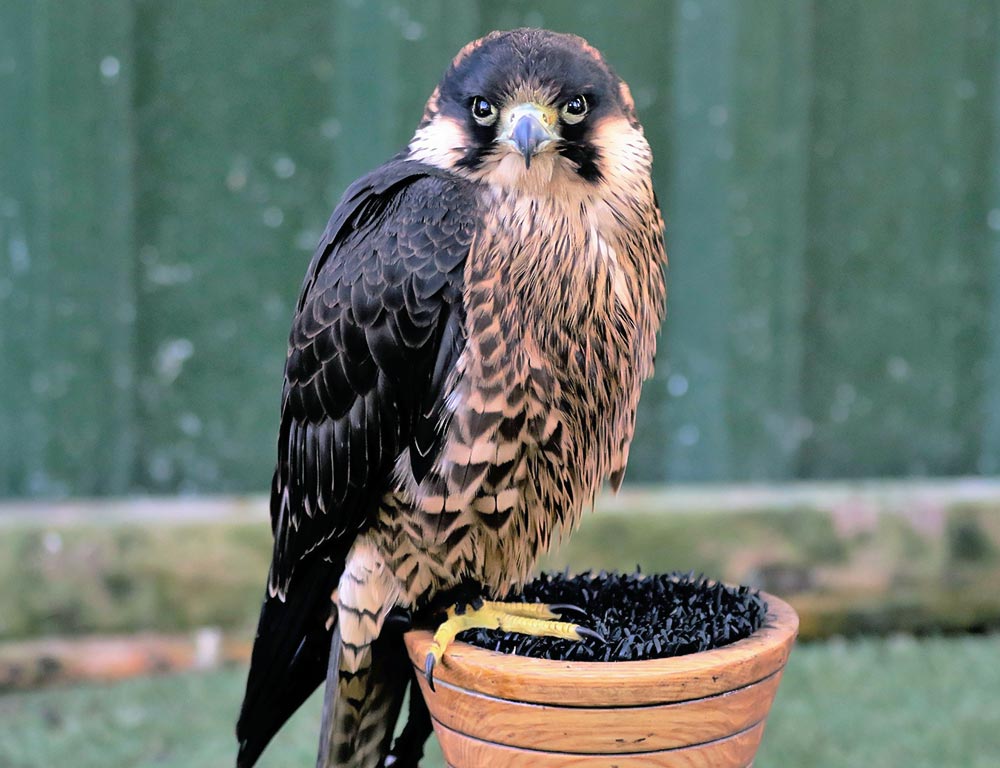
- Scientific name: Falco peregrinus
- Population: Estimated around 3,000 pairs in California
- Life span: Up to 15 years in the wild
- Size: 15 to 20 inches
- Weight: 1.5 to 3.5 pounds
- Food: Primarily birds, occasionally bats; adept hunters known for high-speed dives
- Wingspan: 3.3 to 3.6 feet
- Status: Recovered from endangered status, now listed as a species of least concern
The Peregrine Falcon, a majestic raptor, embodies speed and precision in its hunting prowess. Thriving in California’s diverse ecosystems, this falcon is renowned for its spectacular stoop, a high-speed dive to capture prey mid-air.
With a keen vision, they lock onto their target and reach speeds of over 240 mph during the descent.
Peregrines often nest on cliffs, skyscrapers, or tall structures, providing them a strategic vantage point for hunting. They exhibit monogamous behaviors, forming strong bonds with their mates.
The recovery of the Peregrine Falcon from endangered status reflects successful conservation efforts and highlights their adaptability to urban environments.
2. American Kestrel
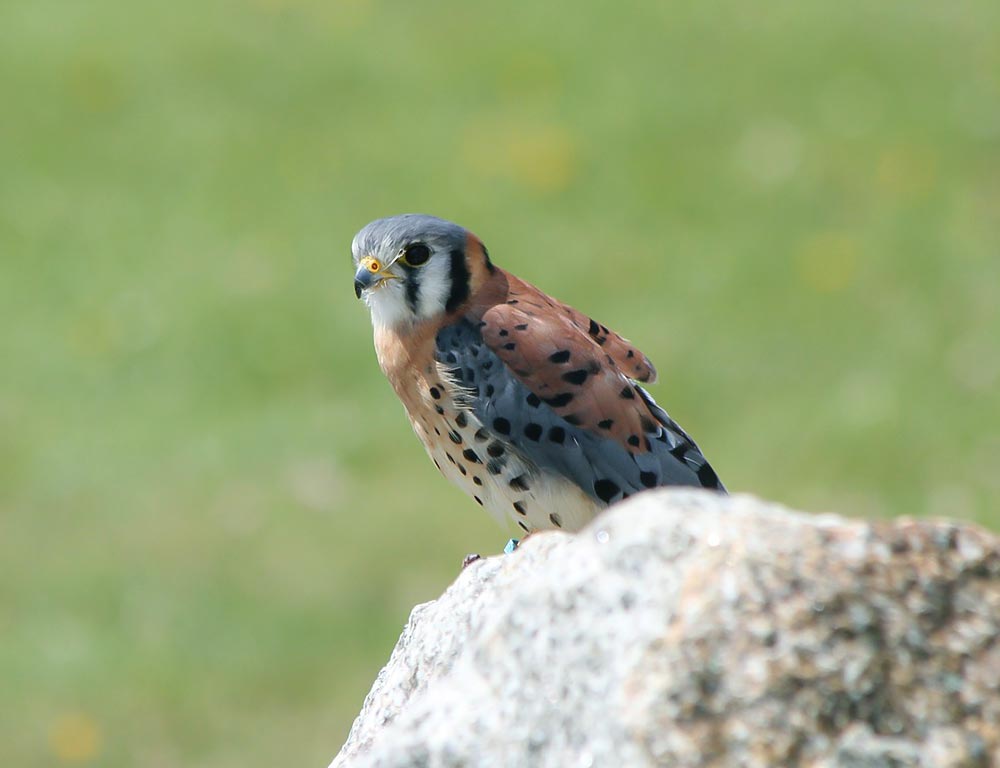
- Scientific name: Falco sparverius
- Population: Common, with around 200,000 individuals in North America
- Life span: 5 to 10 years
- Size: 8 to 12 inches
- Weight: 3.5 to 6 ounces
- Food: Insects, small mammals, birds, and reptiles
- Wingspan: 20 to 24 inches
- Status: Not globally threatened; considered a species of least concern
The American Kestrel, the smallest falcon in North America, graces California with its vibrant plumage and acrobatic flight. Preferring open habitats, these falcons are often found perched on wires or hovering in search of prey.
With a diverse diet, including insects and small vertebrates, they showcase adaptability in their feeding habits.
American Kestrels are cavity nesters, utilizing natural hollows or abandoned woodpecker nests. Despite their small size, these falcons are fierce predators, utilizing their sharp talons and beaks to capture prey.
The American Kestrel’s ability to thrive across various landscapes emphasizes its resilience and adaptability in California’s dynamic ecosystems.
3. American Peregrine Falcon
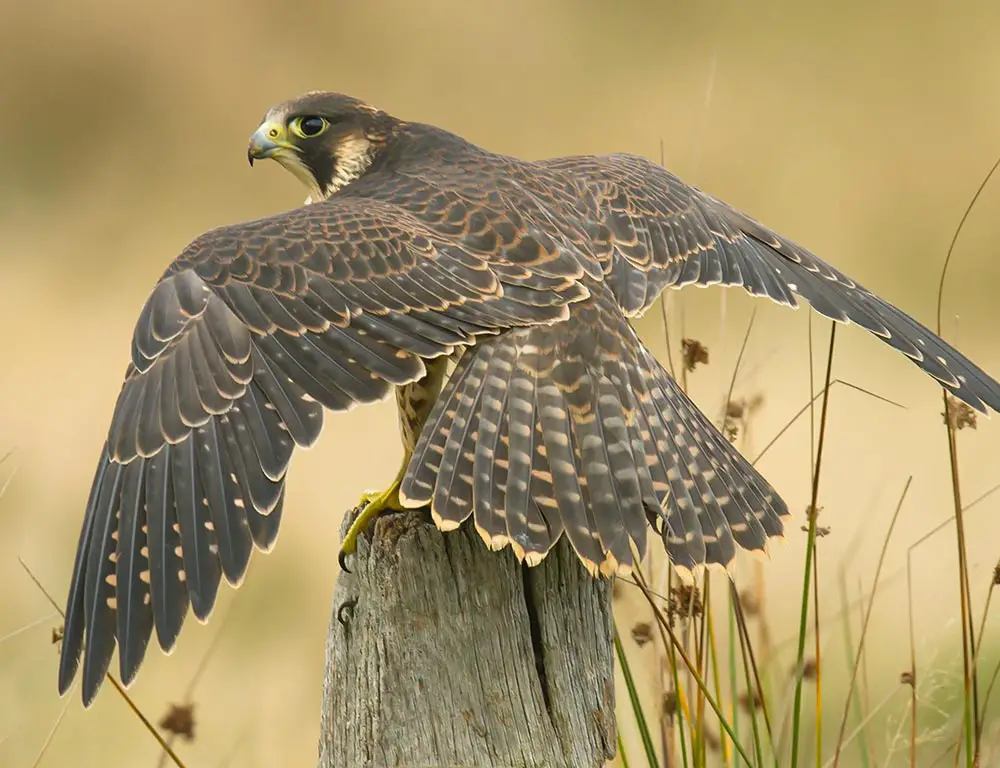
- Scientific name: Falco peregrinus anatum
- Population: Approximately 3,000 pairs in the United States
- Life span: Up to 15 years in the wild
- Size: 15 to 20 inches
- Weight: 1.5 to 3.5 pounds
- Food: Primarily birds; adept hunters with high-speed dives
- Wingspan: 3.3 to 3.6 feet
- Status: Recovered from endangered status, now listed as a species of least concern
The American Peregrine Falcon, a subspecies of the Peregrine Falcon, has remarkably recovered from near extinction due to the banning of the pesticide DDT.
Thriving in diverse habitats, they are often found in urban areas, cliffs, and coastal regions. Known for their breathtaking stoops, they are expert aviators, preying on birds in mid-air with remarkable speed and precision.
Peregrine Falcons exhibit monogamous behaviors, forming strong pair bonds. Their adaptability to various environments and their successful recovery from endangered status symbolize conservation success.
4. Prairie Falcon
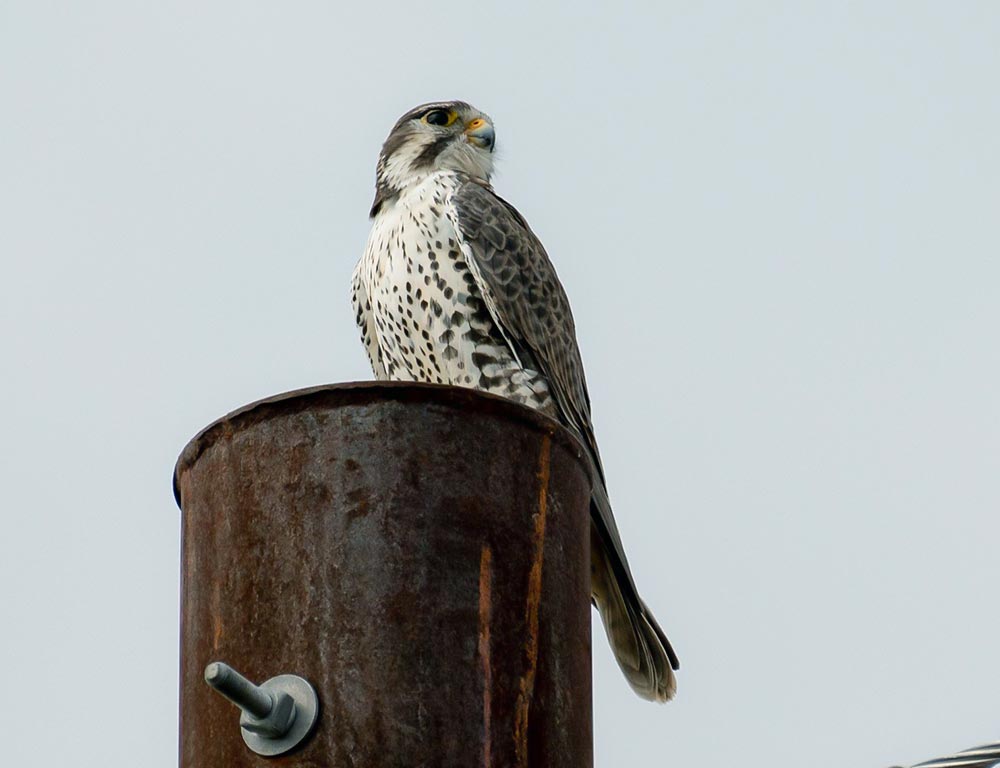
- Scientific name: Falco mexicanus
- Population: Stable, but specific numbers are not readily available
- Life span: Up to 12 years in the wild
- Size: 15 to 20 inches
- Weight: 1.5 to 2.5 pounds
- Food: Small mammals, birds, and occasionally insects
- Wingspan: 3.3 to 3.6 feet
- Status: Not globally threatened; considered a species of least concern
The Prairie Falcon, a skilled hunter of open landscapes, thrives in the arid regions of California. With a preference for prairies, deserts, and cliffs, they are often seen soaring in search of prey.
Their diet includes a variety of small mammals and birds. Prairie Falcons are known for their rapid and direct flight and often nest on cliff ledges.
These falcons display strong territorial behaviors and are particularly adept at adapting to the challenges of living in diverse environments.
Their ability to hunt in vast, open spaces characterizes their lifestyle as a master of the skies in the California landscape.
5. Merlin
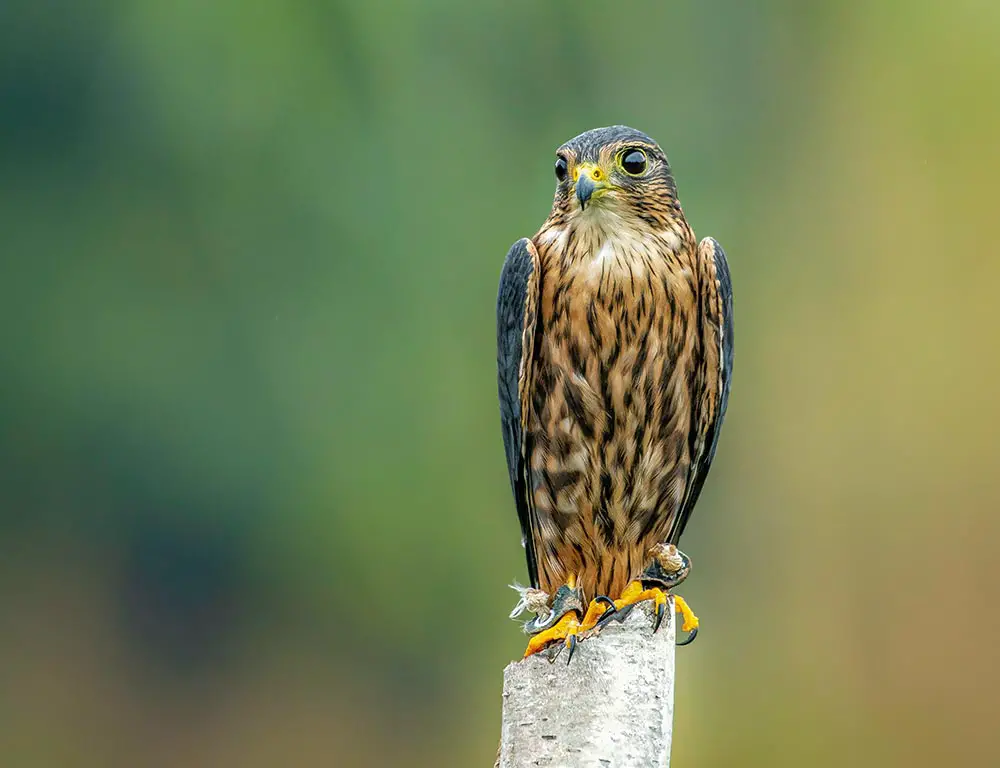
- Scientific name: Falco columbarius
- Population: Common and widespread in North America
- Life span: Up to 10 years in the wild
- Size: 9 to 13 inches
- Weight: 5 to 8 ounces
- Food: Small birds, insects, and occasionally small mammals
- Wingspan: 20 to 26 inches
- Status: Not globally threatened; considered a species of least concern
The Merlin, a compact and agile falcon, is a common sight across various habitats in California. Preferring woodlands, grasslands, and urban areas, they exhibit versatility in their choice of living spaces.
Merlins are skilled fliers, using their rapid and acrobatic flight to capture small birds and insects. They are known for their adaptability, often nesting in abandoned crows or magpie nests.
Merlins are solitary hunters, and during the breeding season, they become more territorial. Their ability to navigate and thrive in both natural and human-altered environments showcases Merlin’s dynamic lifestyle in California.
Ecological Significance of Falcons In California
With its vast and diverse landscapes, Texas offers birdwatchers and enthusiasts excellent opportunities to spot various falcon species.
Here are six elaborative points highlighting the best places to witness these majestic birds in the Lone Star State:
Davis Mountains State Park
Nestled in the Davis Mountains, this park provides a unique habitat for falcons. With its elevation, diverse vegetation, and open skies, it’s an ideal spot to observe both resident and migratory falcon species.
Balcones Canyonlands National Wildlife Refuge
This refuge, northwest of Austin, is renowned for its bird diversity. The rugged canyons and cliffs create suitable nesting sites for falcons, including the Peregrine Falcon and the Prairie Falcon.
South Padre Island
Located along the Gulf Coast, South Padre Island is a hotspot for bird migration. During certain seasons, falcons can be spotted as they rest and refuel on the island, making it a prime location for birdwatching.
Big Bend National Park
The varied landscapes of Big Bend, from desert expanses to mountainous terrain, attract a range of raptors, including falcons. Keep an eye on the skies for the Peregrine Falcon and the Aplomado Falcon.
Caprock Canyons State Park
Situated in the Texas Panhandle, this park features stunning canyons and cliffs. It’s a haven for falcons, with the rugged terrain offering ideal nesting and hunting grounds for species like the Prairie Falcon.
Hueco Tanks State Park
East of El Paso, Hueco Tanks is known for its unique rock formations and cultural history. The cliffs and rocky outcrops provide suitable habitats for falcons, and birdwatchers may spot the fast and agile Merlin in this area.
When embarking on a falcon-watching adventure in Texas, these locations showcase the state’s biodiversity and offer a chance to witness these incredible birds of prey in their natural habitats.
Remember to respect wildlife and follow ethical birdwatching practices while enjoying the beauty of Texas’ falconry heritage.
How to Preserve Falcons In California?
Preserving falcons in California requires a comprehensive approach that addresses various aspects of their habitat, behavior, and potential threats. Here are key strategies to ensure the conservation of falcons in the state:
Habitat Protection and Restoration
Identify and protect critical habitats for falcons, including nesting sites and feeding areas.
Implement habitat restoration projects to enhance the availability of suitable environments, considering the diverse needs of different falcon species.
Monitoring and Research
Conduct regular monitoring programs to track falcon populations, nesting success, and migration patterns.
Invest in research to understand the specific ecological requirements of different falcon species and their responses to environmental changes.
Reducing Human Disturbance
Implement measures to minimize human disturbance, particularly around nesting sites. Educate the public about the importance of keeping a respectful distance from falcon habitats to avoid stressing the birds.
Mitigating Urbanization Impacts
Develop and implement strategies to mitigate the impacts of urbanization on falcons, such as installing nest boxes in urban areas to provide alternative nesting sites.
Controlling Pesticide Use
Advocate for and enforce regulations that restrict the use of harmful pesticides, which can negatively impact falcons directly or affect their prey.
Community Engagement and Education
Raise awareness about the ecological importance of falcons and their role in maintaining a balanced ecosystem.
Engage local communities in falcon conservation efforts through educational programs, workshops, and community events.
Collaboration with Stakeholders
Foster partnerships with government agencies, conservation organizations, and private landowners to collectively work towards falcon preservation. Collaborate on research initiatives, habitat restoration projects, and conservation strategies.
Climate Change Adaptation
Develop and implement strategies to help falcons adapt to the impacts of climate change, such as temperature changes, precipitation patterns, and habitat availability.
Legislation and Policy Advocacy
Advocate for and support legislation that promotes the conservation of falcons and their habitats. Work with policymakers to ensure that environmental policies consider the needs of falcons and their ecosystems.
Rehabilitation and Rescue Programs
Support and participate in rehabilitation programs for injured or orphaned falcons, helping to reintroduce them to the wild when possible.
Preserving falcons in California is a collective responsibility that involves the cooperation of government agencies, conservation organizations, researchers, and the public.
By addressing habitat protection, reducing human impact, and fostering community engagement, we can ensure the survival and well-being of these magnificent birds of prey in the California landscape.
Wrapping Up
Preserving falcons in California is an intricate dance between habitat conservation, community engagement, and research initiatives.
The state’s diverse landscapes provide crucial habitats for various falcon species, emphasizing the need for concerted efforts in their protection.
As iconic predators, falcons play a vital role in maintaining ecological balance. Ongoing monitoring, sustainable urban planning, and advocacy for pesticide control are essential components of a comprehensive conservation strategy.
By fostering a harmonious relationship between humans and these majestic birds, California can ensure the enduring presence of falcons, contributing to the state’s rich biodiversity and the overall health of its ecosystems.